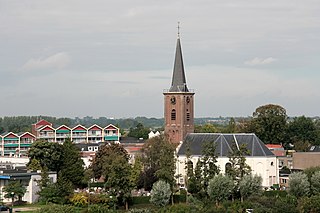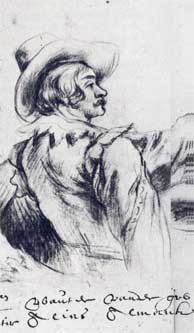
Karel van Mander (I) or Carel van Mander I (May 1548 – 2 September 1606) was a Flemish painter, poet, art historian and art theoretician, who established himself in the Dutch Republic in the latter part of his life. He is mainly remembered as a biographer of Early Netherlandish painters and Northern Renaissance artists in his Schilder-boeck. As an artist and art theoretician he played a significant role in the spread and development of Northern Mannerism in the Dutch Republic.

Mijdrecht is a town in the Netherlands with about 16,000 residents. It is located in the municipality of De Ronde Venen, about 7 kilometres (4.3 mi) west of the main A2 motorway, between Utrecht and Amsterdam.

Rijksdienst voor het Cultureel Erfgoed often abbreviated as Cultureel Erfgoed, is a Dutch heritage organisation working for the protection and conservation of National Heritage Sites. It is located in Amersfoort, province of Utrecht.

The Centraal Museum is the main museum in Utrecht, Netherlands, founded in 1838. The museum has a wide-ranging collection, mainly of works produced locally. The collection of the paintings by the Northern Mannerist Joachim Wtewael is by a long way the largest anywhere in the world. Other highlights are many significant paintings by the Utrecht Caravaggisti, such as Gerard van Honthorst and Hendrick ter Brugghen. Both of them travelled to Rome in the early 17th century to study the works of the Italian master Caravaggio. In the previous generation, as well as Wtewael, Abraham Bloemaert and the portraitist Paulus Moreelse were the most significant Utrecht painters, with Jan van Scorel still earlier.

Wouter Pietersz. Crabeth II was a Dutch Golden Age painter.
Peter van Mensch is a Dutch scholar in the field of museology, and previously a professor of Cultural Heritage at Amsterdam University of the Arts.

Martijn Theodoor Houtsma, often referred to as M. Th. Houtsma, was a Dutch orientalist and professor at the University of Utrecht. He was a fellow of the Royal Netherlands Academy of Arts and Sciences, and a leading expert on the history of the Seljuks. He remains best known for his work as editor of the first edition (1913–38) of the standard encyclopedic reference work on Islam, the Encyclopaedia of Islam.

Van Vloten is a Dutch patrician family from Vleuten.
The Biografisch Portaal is an initiative based at the Huygens Institute for Dutch History in Amsterdam, with the aim of making biographical texts of the Netherlands more accessible.

Agneta Wilhelmina Johanna van Marken-Matthes was a Dutch entrepreneur. She and her husband Jacques van Marken were involved in the manufacture of yeast throughout their lives, and were engaged in the co-operative movement, taking care of their workers. Matthes and Van Marken created living quarters for workers in her hometown, Delft in South Holland, named Agnetapark after her. These are considered a model for the co-operative development and construction of garden cities for workers. Matthes founded and ran a Delft perfume factory, Maison Neuve, to take advantage of a by-product from the yeast factory.

jkvr. Mariane Catherine van Hogendorp, a member of the Van Hogendorp family, was a Dutch feminist. She founded the Nederlandsche Vrouwenbond ter Verhooging van het Zedelijk Bewustzijn.

Petronella Oortman was a Dutch woman whose elaborate dollhouse is part of the permanent collection of the Rijksmuseum in Amsterdam.

Jhr. Johannes Cornelis de Jonge was a Dutch Rijksarchivaris, historian, and politician. He is best known for his encyclopedic Geschiedenis van het Nederlandsche Zeewezen, a naval history of the Netherlands that was based on the Dutch naval archives, a large part of which were destroyed in a fire in the archives of the Dutch Department of the Navy in 1844. By default therefore this history had to come in the place of the lost primary documents.
Jacquemijntje Garniers was a midwife, and possibly an amateur painter, from Ypres, West Flanders. She was widowed four times and had a total of four children, including the Dutch painter Gabriël Metsu. She was a city midwife in Leiden, in the modern province of South Holland, and also worked as an independent midwife. She died in Leiden and had silver objects and three houses in her possession at the time of her death.

The Ubica buildings are two adjacent buildings standing at 24 and 26 Ganzenmarkt, in central Utrecht, the Netherlands. Number 24 is a rijksmonument. The first recorded mention of the buildings is from 1319. After centuries of residential use, the buildings were bought by the Ubica mattress company in 1913 and used until a devastating fire in 1989. The buildings were then squatted for 21 years, before being redeveloped into a hotel and café-restaurant in 2014.

Marie Heijermans or Marie de Roode-Heijermans (1859-1937) was a Dutch painter.

Hildegard Brom-Fischer (1908-2001) was a Dutch textile artist, specializing in ecclesiastical embroidery.

Cornelia "Corrie" Johanna Pabst (1865–1943) was a Dutch artist.

Henriëtte Johanna Reuchlin-Lucardie (1877-1970) was a Dutch painter.
















